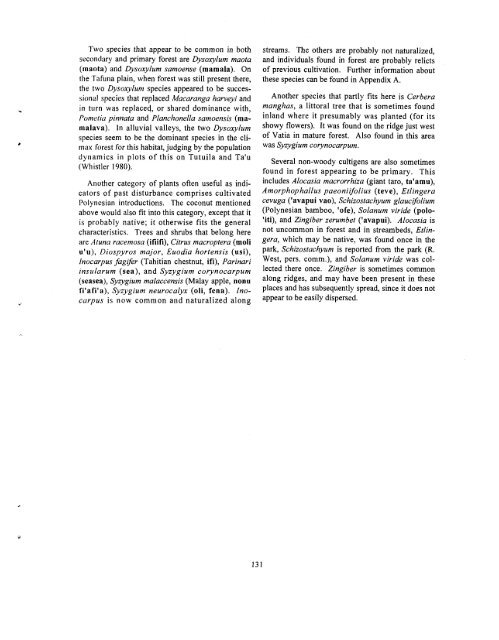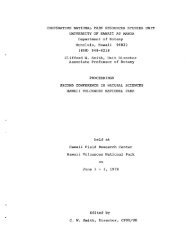american samoa - University of Hawaii at Manoa
american samoa - University of Hawaii at Manoa
american samoa - University of Hawaii at Manoa
You also want an ePaper? Increase the reach of your titles
YUMPU automatically turns print PDFs into web optimized ePapers that Google loves.
Two species th<strong>at</strong> appear to be common in both<br />
secondary and primary forest are Dysoxylum maota<br />
(maota) and Dysoxylum samoense (mamala). On<br />
the 'Tafuna plain, when forest was still present there,<br />
the two Dysoxylum species appeared to be succes-<br />
sional species th<strong>at</strong> replaced Macaranga harveyi and<br />
in turn was replaced, or shared dominance with,<br />
Pomctiu pinn<strong>at</strong>a and Planchonella sarnoensis (ma-<br />
malava). In alluvial valleys, the two Dysoxylum<br />
species seem to be the dominant species in the cli-<br />
max forest for this habit<strong>at</strong>, judging by the popul<strong>at</strong>ion<br />
dynamics in plots <strong>of</strong> this on Tutuila and Ta'u<br />
(Whistler 1980).<br />
Another c<strong>at</strong>egory <strong>of</strong> plants <strong>of</strong>ten useful as indi-<br />
c<strong>at</strong>ors <strong>of</strong> past disturbance comprises cultiv<strong>at</strong>ed<br />
Polynesian introductions. The coconut mentioned<br />
above would also fit into this c<strong>at</strong>egory, except th<strong>at</strong> it<br />
is probably n<strong>at</strong>ive; it otherwise fits the general<br />
characteristics. Trees and shrubs th<strong>at</strong> belong here<br />
are Aluna rucemosa (ifiifi), Citrus macroptera (mob<br />
u'u), Diospyros major, Euodia hortensis (usi),<br />
lnocarpus fagifer (Tahitian chestnut, ifi), Parinari<br />
insularum (sea), and Syzygium corynocarpum<br />
(seasea), Syzygium rnalaccensis (Malay apple, nonu<br />
fi'afi'a), Syzygium neurocalyx (oli, fena). Ino-<br />
curpus is now common and n<strong>at</strong>uralized along<br />
streams. The others are probably not n<strong>at</strong>uralized,<br />
and individuals found in forest are probably relicts<br />
<strong>of</strong> previous cultiv<strong>at</strong>ion. Further inform<strong>at</strong>ion about<br />
these species can be found in Appendix A.<br />
Another species th<strong>at</strong> partly fits here is Cerbera<br />
manghas, a littoral tree th<strong>at</strong> is sometimes found<br />
inland where it presumably was planted (for its<br />
showy flowers). It was found on the ridge just west<br />
<strong>of</strong> V<strong>at</strong>ia in m<strong>at</strong>ure forest. Also found in this area<br />
was Syzygium corynocarpum.<br />
Several non-woody cultigens are also sometimes<br />
found in forest appearing to be primary. This<br />
includes Alocasia macrorrhiza (giant taro, ta'amu),<br />
Amorphophallus paeoniifolius (teve), Etlingera<br />
cevuga ('avapui vao), Schizostachyum glaucifolium<br />
(Polynesian bamboo, '<strong>of</strong>e), Solanum viride (polo-<br />
'iti), and Zingiber zerumbet ('avapui). Alocasia is<br />
not uncommon in forest and in streambeds, Etlin-<br />
gera, which may be n<strong>at</strong>ive, was found once in the<br />
park, Schizostachyum is reported from the park (R.<br />
West, pers. comm.), and Solanum viride was col-<br />
lected there once. Zingiber is sometimes common<br />
along ridges, and may have been present in these<br />
places and has subsequently spread, since it does not<br />
appear to be easily dispersed.
















